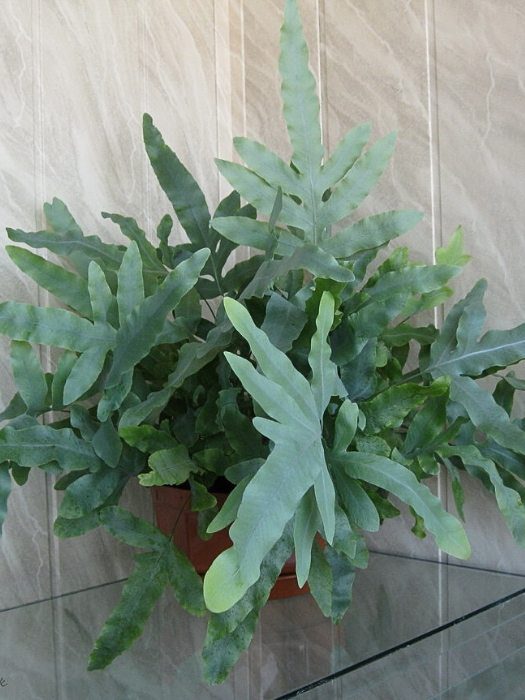The Blue Fern (Phlebodium aureum) is a charming plant belonging to the Polypodiaceae family. Native to tropical regions of the Americas, this fern is widely appreciated for its beauty and lushness. Its natural habitat ranges from southern Florida and the Bahamas to Central America and parts of South America, including countries such as Brazil, Colombia, and Venezuela.
The Blue Fern is a perennial herbaceous plant with rhizomes covered with fine, golden hairs that extend through the substrate, promoting its attachment. It can grow as a terrestrial or epiphytic plant, often colonizing the fibrous stipe of some palm trees. Its fronds are glaucous, meaning they have an emerald-green color that can vary in shades of bluish-gray due to a thin blue waxy coating on their surface.
Each frond is pinnate, with the leaflets, which are smaller segments of the leaf, attached at the base, giving the fronds a lobed appearance. Each frond can reach about 24 to 39 inches in height, depending on the growing conditions. The plant produces spores on the mature fronds, which cluster into brown, circular sori on the underside of the leaves and are released into the environment for reproduction. Among the popular cultivars of Phlebodium aureum, “Blue Star” stands out for its even more intense bluish hue, and “Mandaianum” has narrower, wavy, and elongated leaflets.

Due to its exotic, tropical, and elegant appearance, the Blue Fern is often used in landscaping projects, especially in shady gardens or indoor areas such as balconies, vertical gardens, as well as in pots and hanging baskets. Its presence brings a touch of freshness and harmony to spaces, making it an excellent choice for those seeking a natural and unique decoration. Besides its aesthetic beauty, Phlebodium aureum has properties that make it an interesting plant. It is believed to be capable of purifying the air by removing certain toxins present in the environment. Another interesting fact is that the bluish color of its leaves results from the interaction between sunlight and the chemical composition of the wax on the leaf surface.

The ideal light for the Blue Fern is indirect light or partial shade, as direct sunlight exposure can damage the leaves. As for the substrate, a mixture of garden soil, peat, and sphagnum is a good option to ensure the healthy development of the plant. If you prefer a ready-made substrate, use those designed for ferns, which are fibrous and well-draining.
This fern prefers mild to warm temperatures, between 64°F and 81°F, so it’s important to avoid very cold locations susceptible to frost. It thrives in environments with high humidity, which can be achieved through frequent leaf misting and proximity to water sources such as small reservoirs, waterfalls, humidifiers, or other plants.
Regarding watering, it’s essential to keep the substrate consistently moist but not waterlogged, as excessive water accumulation can lead to root rot. During dry periods, pay extra attention to watering to prevent the plant from becoming dehydrated. It’s recommended to use organic liquid fertilizer or slow-release granules, following the manufacturer’s instructions, to ensure balanced nutrition for the fern.
Phlebodium aureum can be propagated by dividing the rhizomes or by spores. Rhizome division should be done carefully, ensuring that each new plant contains healthy roots and leaves. Propagation by spores requires a more complex process, where spores are collected from mature fronds, germinated in a suitable substrate in humidity boxes, and subsequently transplanted into individual pots.


